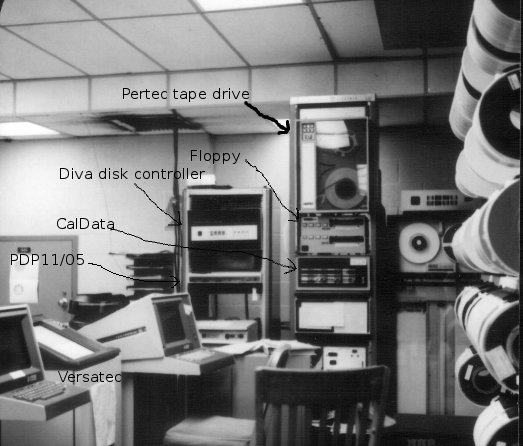PDP-11s
In 1975 I got severely bored at Rolla and went looking for
a summer job in St. Louis, my friend Kurt Horton was looking
to move to computing facilities at WU, but didn't want
to abandon his boss, Rudy Husar, who was running the Air
Pollution Research Lab under the Dept. of Mechanical
Engineering. (Kind of shows what an interdisciplinary
place WU is.) So, I picked up the job at the Air Pollution Lab,
and started working with PDP-11's. We had one with some
floppy disks, then Prof. Scandrett in Physics invented his
own network, actually a disk server, called the spider net. He had a PDP-11
hooked to an IBM 360 channel, and they let him have an
entire disk pack. He broke it up into sections, and
had section zero filled with DOS-11 and compilers, utilities,
etc. The rest of the sections were doled out to various
users. This was a much better system than the limited floppies.
Shortly after moving to this system, we changed to RT-11.
Then we got a CalData PDP-11 emulator, and hooked a
DIVA disk system to it. This used Calcomp 40 MB 14"
removable platter drives and an Interdata 7/16 mini
as an emulator for DEC disk controllers. It was insanely
expensive, but it was compatible with other units at
WU. It was quite reliable, it even survived having
water poured on the drives while it was running.
We did have some traces burned off the electronics
backplane in the drive, but the Calcomp tech fixed it!
We ran RSX-11M on that system, much to the consternation
of DEC. We later upgraded to a used PDP 11/45.
I was the sysadmin on that system, as well as the hardware
maintainer, and wrote/modified device drivers, did
sysgens of the OS, etc. We had a Pertec tape drive
with Datum controller.
 |
This is the CAPITA (Center for Air Pollution Information
and Trend Analysis) computer room about September, 1978.
On the right is the tape library, and just left
of that is an ANCIENT Potter IBM-compatible tape drive
I got surplus. Below the Diva disk controller,
you can see one of the Calcomp 40 MB disk drives.
We eventually had 3 of them. On either side of the
Versatec 1200A printer are two Tektronix storage tube
terminals, a 4012 and a 4014, I think.
|
One of the tricks I came up with was a double-buffered
program to dump and restore an entire disk pack to mag
tape in about 10 minutes. It required error-free disk
media, as it was a block for block copy, but it was
maybe 20 X faster than a file system backup. It had
to poll the tape controller to detect the done condition
and stuff the next operation in before the "reinstruct
window" closed. If you could do that (it was about 10 us)
you could make a start-stop tape drive stream, and it
would write 40 MB in 1600 BPI mode without stopping the
tape for the entire reel.
Intel 8008 systems
Some profs at WU developed an air pollution measuring
instrument for particulates called the beta gauge.
It had a roll of filter paper that air was sucked
through, and a beta source and detector measured the
accumulation of particles on the filter. At
certain intervals the paper was advanced.
Back in 1976 we got a project to commercialize the
beta gauge, and I started developing software on
an 8008. We built a prototype using Intel MAC 8
development system boards and some custom wire-wrapped
interfacing. I got to deliver the prototype to
the company in Pasadena, and got to check out the
C&H store there, which was a truly awesome surplus
outfit, although pretty expensive.
I built my first computer using the 8008 and 256 bytes
of static RAM. No peripherals at all, but it had
a hex keypad and LEDs for a display. The only
program I wrote for it was one that played music
through an AM radio. (What CAN you do in 256
bytes??)

